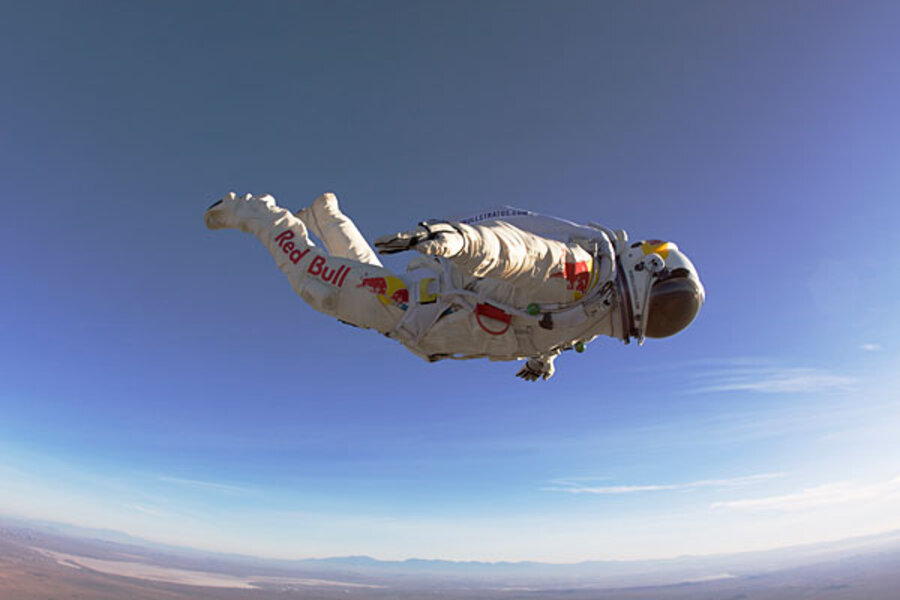Red Bull-fueled daredevil plans record skydive from edge of space
Loading...
One man's quest to make a record-breaking leap from near the edge of space is nearing make-or-break time.
Sponsored by energy drink Red Bull, Austrian extreme athlete Felix Baumgartner, 41, plans to skydive from a balloon in the stratosphere at an altitude of 120,000 feet (36,576 meters).
If he can do it, he'll become the first person to break the sound barrier outside of an aircraft. He'll also break a trio of other records that have stood for more than 50 years: Baumgartner's plunge would mark the highest skydive, the highest manned balloon flight and the longest free fall, at about 5 minutes and 30 seconds.
The quest, called Red Bull Stratos, recently got back on track after being stalled by a legal challenge claiming that the idea of the dive was earlier suggested to Red Bull by California promoter Daniel Hogan. That suit has now been settled out of court, and the Red Bull Stratos project is moving forward.
Baumgartner's balloon is set to launch from Roswell, N.M., in August, according to the Daily Mail.
Jumping for science
While the dive will certainly offer an adrenaline rush and major bragging rights, Baumgartner says he's jumping for science, too.
The team will study Baumgartner's physical condition and the effects of such a dive on the human body in an effort to better understand how people can survive in space. [Photos: Training for Red Bull's Supersonic Space Jump]
"This mission is all about pioneer work," Baumgartner said in a statement released Tuesday (Feb. 7). "Maybe one day people will look back and say it was Felix Baumgartner and the Red Bull Stratos team that helped to develop the suit that they're wearing in space. We want to do something for posterity."
The Red Bull Stratos team also includes aerospace engineers who are custom-designing cutting-edge technology for the jump.
"We'll be setting new standards for aviation," said Red Bull Stratos medical director Jonathan Clark, a former space shuttle crew surgeon. "Never before has anyone gone supersonic without being in an aircraft. Red Bull Stratos is testing new equipment and developing the procedures for inhabiting such high altitudes as well as enduring such extreme acceleration. The aim is to improve the safety for space professionals as well as potential space tourists."
Risky mission
To make the dive, Baumgartner will ascend higher than four times the height of Mount Everest inside a custom-made pressurized capsule pulled up by a single helium-filled plastic balloon about 600 feet (182 meters) wide.
Roughly 35 seconds after he jumps out, Baumgartner will reach supersonic speeds and will continue freefalling until he is about a mile above the ground, when he will deploy his parachute.
The risks involved are multifold. At such lofty altitudes, Baumgartner will need a special pressure suit to insulate him against the thin air, freezing temperatures and low pressures. He must also resist falling into an uncontrolled spin, which could render him unconscious.
The team tried out some of the equipment and procedures Baumgartner plans to use during his jump in a recent test inside a vacuum chamber at Brooks City-Base in Texas.
"This test was enormously important for our self-confidence. The success has given us an additional boost to rise to the challenges that still lie ahead,” Baumgartner said.
The team plans to conduct the first manned test flights at altitude soon.
Breaking records
Baumgartner previously became the first person to cross the English Channel in freefall in 2003. He's also made record-breaking parachute jumps from some of the world's tallest structures, including the World Financial Center T101 in Taipei, Taiwan, and the statue of Christ the Redeemer in Rio de Janeiro, Brazil.
He is now attempting to break records set in 1960 by U.S. Air Force Captain Joe Kittinger, who leaped from a balloon at an altitude of about 102,800 feet (31,333 meters).
Since then, others have tried and failed to beat his performance. New Jersey native Nick Piantanida died trying to set a new record in 1966.
Now Kittinger is part of the Red Bull Stratos team, advising Baumgartner.
You can follow SPACE.com assistant managing editor Clara Moskowitz on Twitter @ClaraMoskowitz. Follow SPACE.com for the latest in space science and exploration news on Twitter @Spacedotcom and on Facebook.





